Part 7: British Railways - The Diesel Era
The Coming of the Diesels
The 350bhp Shunters
Discounting the LMS articulated diesel unit which we have already covered, the first signs of diesel traction at Cambridge were in the early 1950s when a pair of LMS-designed diesel-electric Class 11 shunters appeared. These were never officially allocated to Cambridge and were given trials in the hump yard. One is known to have been 12133 and the other is thought to have been 12137.
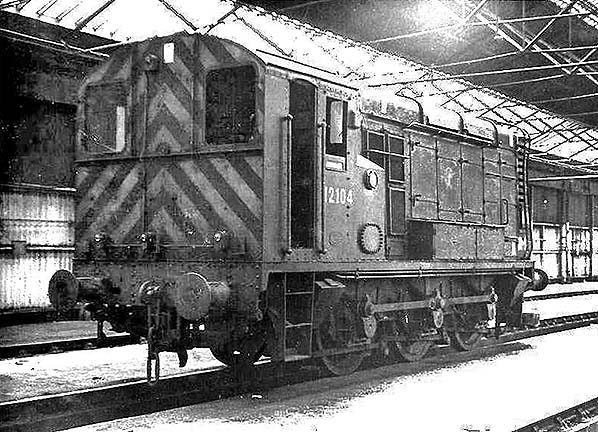
Photo by Hugh Llewelyn reproduced from Wikimedia Commons under creative commons licence
The above image is not of the best quality but adequate to illustrate the Class 11 at close quarters. 12104 is seen at Stratford in July 1967. It had been officially withdrawn two months earlier.
The Class 11, as the type came to be classified, originated with the LMS experiments of the 1930s. There were several types by English Electric, Hawthorn-Leslie and Armstrong Whitworth; some used a twin motor design, others a single motor and jackshaft drive. The Class 11 was a twin motor type and appeared from 1945 onwards. Their history is too complex for this feature but, briefly, the first batch was built for the War Department with some ending up with the Nederlandse Spoorwegen (Dutch State Railways). Eventually the NS ended up with around 100 of the type. Yet more were built for Australia and there were some metre-gauge examples built for Malaya. Of the original War Department batch, others went to the LMS and were numbered in that company's series as 7120 - 7126. Others followed and with nationalisation some were numbered by BR in the LMS series but with an M prefix. In time the whole class became BR Nos 12033–12138 (12003 - 12032 were jackshaft drive locomotives). Derby built locomotives up to and including 12102 and Darlington built Nos 12103 - 12138.
Those built at Darlington were specifically intended for the Eastern Region and that is where they spent most of their lives. For several years during the 1960s, Cambridge had 12134 and 12136 on its allocation. The class was not, during BR days, fitted with train brakes so they were invariably found, including at Cambridge, pottering around in goods yards. The type was extinct on BR by 1972 but many went into industrial service and as a result a few have survived into preservation. A number of the Dutch examples have also returned to Britain for preservation. The class was the basis of the ubiquitous BR Class 08/09/10 shunter but there was a number of differences between the two types. The Class 11 could be distinguished, ignoring the numbers, by the less arched cab roof, rectangular front windscreens and a different arrangement of the various boxes on the running plates. They also lacked train brakes; this become more apparent as other types appeared with, or were subsequently fitted with, them.
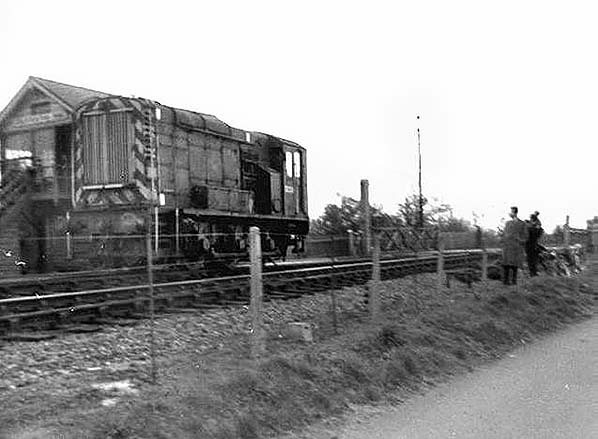
Photo by Stewart Ingram
Above 12134 is seen at Chesterton Junction sometime during the 1960s. Whether it is shunting or returning to Cambridge depot is not known. There appears to be no tail lamp and the level crossing gates open to the railway does not necessarily mean the shunter is heading south.
Cambridge later had a number of what became the BR Class 08 and 10 variants. D3610/1 were sent to Cambridge when new in 1958 and were later joined by D3608. These three later became 08495/6/3 respectively. D3608 had been transferred from Stratford in 1962 and all three were to spend much of their lives at Cambridge. They were later joined by D3661 and D3883, then after the Class 03s were withdrawn during the 1970s further examples of the 08s arrived. Of those later additions, what had become 08100 was seen busying itself with track lifting work during the singling of the Newmarket line in 1982/3 and 08108 found a new home at Newmarket in industrial use.
Cambridge also saw a couple of the Blackstone-engined Class 10 variant. D3493 spent a brief period at 31A in 1960/1 while D3634 appeared in 1969. The latter is thought to have been sent to Cambridge out of the need for an extra shunter in connection with track lifting on the Stour Valley Line and the remaining stub of the Saffron Walden branch at Bartlow. The Blackstone engines of the Class 10 were well known for emitting a dense cloud of black smoke when the throttles were opened. As a point of interest there was also a Crossley engined variant, all withdrawn in the late 1960s and as far as is known none ever appeared at Cambridge.
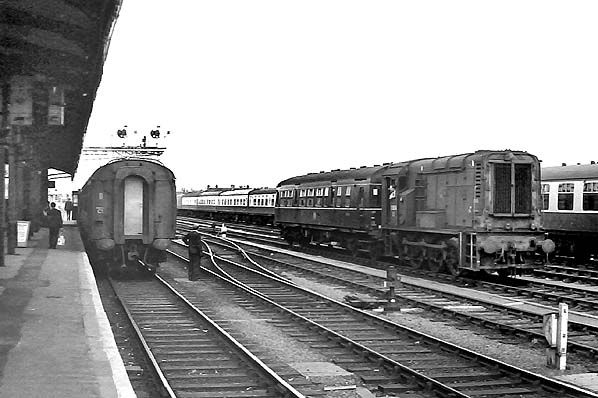
Photo by Alan Brown
Above, January 1970 sees Blackstone / GEC Class 10 D3634 with Metro-Cammell DMU car E51213 in tow. A Stratford locomotive for much of its life, it was transferred to Cambridge in 1969 and then to Doncaster during 1971 from where it was withdrawn during November of that year. A chat with the driver of D3634 one day when it was stabled in the loading dock behind platform 3 revealed it had been sent to Cambridge to assist with the extra work involved in lifting the Stour Valley line and the surviving stub of the Saffron Walden branch at Bartlow. In practice, however, the tracklifting trains were generally operated by Class 31 locomotives. D3634 is carrying one of BR's blue data stickers below its number and this would have been duplicated on the other side of the cab. The train on the left has had its tail lamp removed and dumped on the platform; this and the shunter chap standing on the ground suggests a locomotive is about to be attached to this end of the train.
In the distance one of the pre-nationalisation buffet cars can be seen and it appears to be one of the Thompson cars, either E1705E or E1706E.
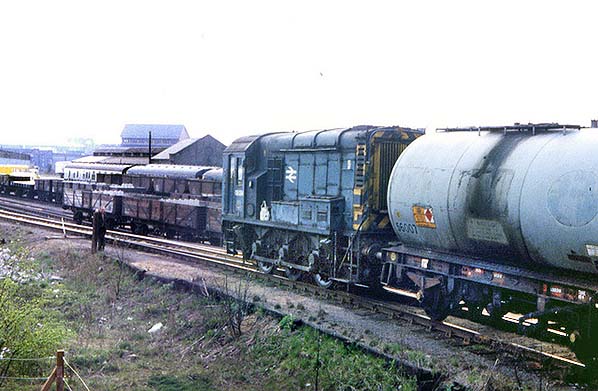
Photo
by Pat Newson from Cambridge area 1980s Flickr photostream
Above, in 1982 a Class 08 is busy hump shunting. There was still a fair amount of wagon-load traffic at this time but within a decade scenes like this would be all-but history. The photograph was taken from the former hump control tower, by then derelict. In the background can be seen the former GNR goods shed and beyond that Cambridge PSB.
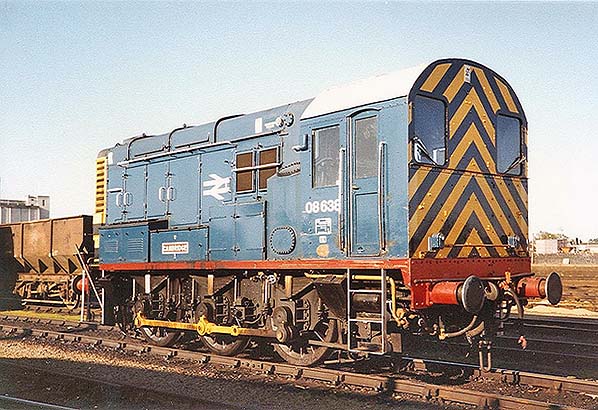
Photo
by Pat Newson from Cambridge area 1980s Flickr photostream
Taken around the same time as the previous image, above is 08638 Cambridge. This locomotive was kept in a poshed-up condition as depot mascot but is looking a little grubby on this occasion. She had begun life as D3805 in 1958 and had spent some time on the Western Region. She was withdrawn in 1981, reinstated in 1984, survived a further eight years in service and was eventually scrapped in 1994.
The 153bhp - 330bhp Shunters
BR had numerous type of 204hp diesel-mechanical shunter and all used the Gardner 8L3 engine. the Hunslet offering, later Class 05, was once common throughout Eastern England but only one example is said to have been at Cambridge. This was 11174, later D2571, and a photograph exists of it supposedly taken at Cambridge but this location has proved difficult to confirm. After spending much of its life in East Anglia, including a spell at Yarmouth Beach, D2571 ended up at Speke (Liverpool).
 The Drewry offering, later Class 04, was also uncommon at Cambridge despite being prolific at Stratford and a number of sheds in East Anglia. Two which did appear at Cambridge were D2200 (originally 11100) and D2217 (originally 11123). The former was one of the early examples and remained at Cambridge for only a week during September 1962. The latter spent a while at Cambridge in 1957 8, then reappeared briefly on a couple of other occasions during the 1960s. Other then its spells at Cambridge, D2217 was a Stratford locomotive all its life. It was to go on to be the last example of its class in BR service, finally bowing out in May 1972. Stratford was home to a fascinating variety of small diesel shunters, many seemingly spending a great deal of time standing idle on shed. Much of their intended work was in the London docks but as that declined and the general need for shunting locomotives declined, many with withdrawn after very short lives. Numerous examples were sold to industrial concerns where they continued to work for much longer than they did with BR.
The Drewry offering, later Class 04, was also uncommon at Cambridge despite being prolific at Stratford and a number of sheds in East Anglia. Two which did appear at Cambridge were D2200 (originally 11100) and D2217 (originally 11123). The former was one of the early examples and remained at Cambridge for only a week during September 1962. The latter spent a while at Cambridge in 1957 8, then reappeared briefly on a couple of other occasions during the 1960s. Other then its spells at Cambridge, D2217 was a Stratford locomotive all its life. It was to go on to be the last example of its class in BR service, finally bowing out in May 1972. Stratford was home to a fascinating variety of small diesel shunters, many seemingly spending a great deal of time standing idle on shed. Much of their intended work was in the London docks but as that declined and the general need for shunting locomotives declined, many with withdrawn after very short lives. Numerous examples were sold to industrial concerns where they continued to work for much longer than they did with BR.
The most familiar type of 204hp diesel shunter at Cambridge was that which became BR Class 03. These were introduced in 1958 and Cambridge received D2004 - 10, D2013 - 17, D2028 - 31. All of these were sent to Cambridge when brand new. Later, D2050 (03050) was to appear. The 03s were built by BR at Swindon and were nothing more than BR's version of the Drewry Class 04. The Drewry Car Co. did not build its own locomotives, they simple acted as agents. As a result the Class 04 was built by Vulcan Foundry and Robert Stephenson & Hawthorn. They carried both Drewry and builders works numbers.
Of the Cambridge Class 03s, some were quickly transferred away never to return while others, such as D2016, came, went, then came back again. Of the original allocation, D2004 - 8 were to spend their entire lives at Cambridge. D2009 almost did but had a brief spell at Colchester before being withdrawn.
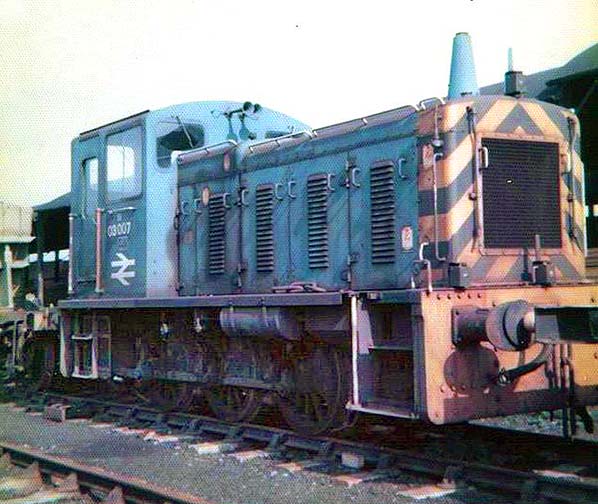
Photo by Paul Miller reproduced from Wikimedia Commons under creative commons licence
Two of the class were seen in an earlier image in their original green livery, while above is 03007 in rather shabby condition. The location appears to be the sidings just south of Coldhams Lane diesel depot. She was probably withdrawn when the photograph was taken, May 1976 being her withdrawal date, although the windscreen wipers appear to have been used recently. D2006 was an earlier withdrawal, going in 1972. She was never to receive blue livery or, of course, a TOPS number. D2006 remained in green when the other Cambridge examples had received blue livery, so her early withdrawal must have been preplanned but the reason is not known.
We have already mentioned the two other 03s at Cambridge; Dept.91 and 92. These resided usually at Chesterton Junction PW depot and were a pair built as part of the original batch with conical chimneys. The pair later became D2370/1 and then 03370/1 in capital stock. D2371 was transferred away almost immediately but D2370 remained at Cambridge for a few more years before being transferred away herself.
The Cambridge 03s certainly got around. As well as station pilot work, where they struggled with 8 or 9 coach rakes of Mk1 stock, and goods yard work, many were also outstationed. One was at Saffron Walden, one at Ely, one at Newmarket, one at Bury St Edmunds and one at St. Ives / Huntingdon East. They were swapped at intervals for maintenance purposes, usually running under their own power to / from Cambridge.
The Saffron Walden example shunted the yard at that station and also worked the branch goods after the passenger service was withdrawn. When not in use it was normally stabled in Foundry Siding, opposite the east end of the station. A familiar photograph exists showing an 03 in Foundry Siding but is always incorrectly captioned as showing D2003. D2000 - 3 were never allocated to Cambridge. The Class 03 shunters were not unknown on branch line passenger trains and that at Saffron Walden was no exception. When the railbuses were introduced a set of the former push-pull stock was retained at Saffron Walden for a time just in case and was pressed into service with the diesel shunter on at least one occasion. Whilst this might appear comical, the Class 03s stated maximum speed was 28mph but they were capable of exceeding this. On short branch lines where passenger trains ambled along at no more than 30mph anyway, an 03 and a couple of carriages did the job perfectly well. Drivers just had to remember to change gear smoothly.
The Newmarket 03 outstation was something of an oddity as it shared its work with horses. The Newmarket 03 seems to have been abolished quite early but the horses continued until 1967. The 03 at St.Ives shunted the various sidings there but could often be seen at Godmanchester or Huntingdon East. One of its duties was tripping wagons along that stretch of line. This was another short-lived duty as the St.Ives - Huntingdon East line had closed completely by 1962. Occasionally a Cambridge 03 would trip wagons to Histon, on the Cambridge - St.Ives line, but normally this was a job for a main line locomotive.
The Ely and Bury St. Edmunds outstations were the final two to survive and were latterly operated by Cambridge Class 08s. One the duties of the Bury St. Edmunds outstation was tripping wagons to Thurston, the next station east from Bury.
Two other BR diesel shunters at Cambridge were the relatively little known narrow gauge pair at Chesterton Junction. Chesterton PW yard had an internal 2ft gauge system worked by a pair of Ruston & Hornsby locomotives. Both are believed to have survived into preservation.
From time to time other shunting types would appear, sometimes commandeered for a spot of work on their way to a transfer and sometimes just passing through to or from works.

© National Railway Museum and SSPL
The NRM information with the above photograph gives the location as both March and Cambridge. It is in fact Cambridge. On 5 March 1959 a Class 03 in original livery undergoes maintenance in Cambridge diesel depot. The depot had opened six months previously; it was mainly for DMUs but could also handle minor repairs and routine servicing of diesel locomotives.
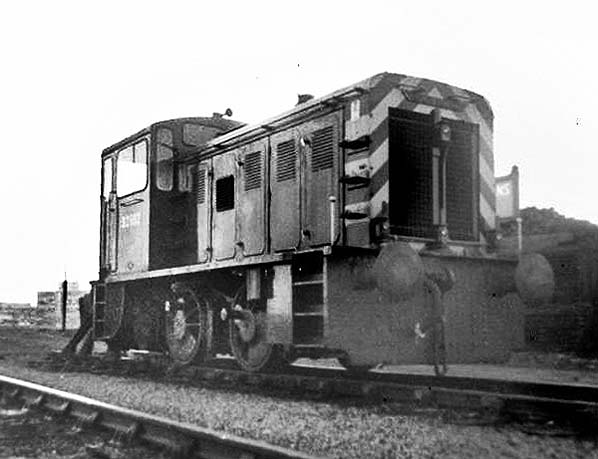
Photo by Stewart Ingram
Above North British (NBL) 330hp 0-4-0 diesel-hydraulic D2902 can be seen at Cambridge. Fourteen members of the class appeared in 1958 and allocations were rather scattered; D2902 began life at Devons Road, Bow, before moving to Stratford in 1964. It was reallocated to Crewe works in 1966 and the photograph was likely taken during that transfer. It was withdrawn in 1967. The coupling rods have been removed, this being normal procedure when so-fitted locomotives were being towed. Transfer would have been in freight trains and D2902 would have probably reached Crewe from Cambridge via the Bletchley line.
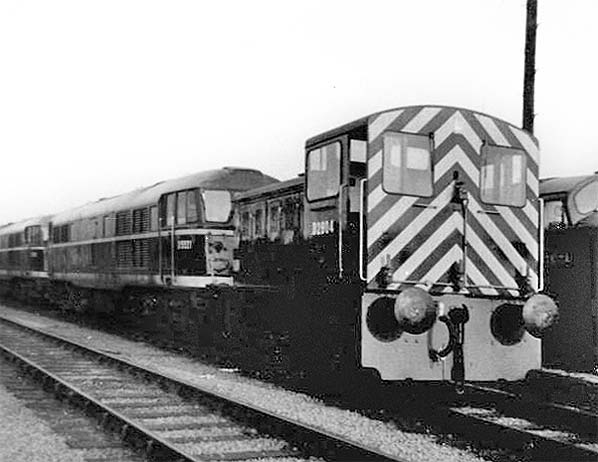
Photo by Stewart Ingram
Above is D2904 of the same class on 'the dump' at Cambridge. 'The dump' was the diesel stabling point set up on the roads which once led to Cambridge steam shed; the somewhat derogatory name seems to have been invented by local rail enthusiasts but also came to be used by railwaymen. D2904 also began life at Devons Road and, after a little shuffling around, also end up at Stratford. It was transferred to Wolverton works in 1966 before moving to Crewe Diesel later that same year. Stratford ridded itself of both locomotives at the same time so the above images were probably taken at the same time. As D2904 left Cambridge for Wolverton and like D2902 it would almost certainly have gone via Bedford and Bletchley.
The entire class had been withdrawn by the end of 1967 after a dismally short life. None survived but near-identical locomotives were supplied to industry and one or two of those somehow managed to survive. They worked well, when they were working well - which they seldom did.
The black / yellow chevrons commonly referred to as wasp stripes became standard across the entire BR diesel shunter fleet. The idea was to make the locomotives more visible to men on the ground; compared to steam locomotives, diesel shunters were relatively quiet and could catch men unawares when they were preoccupied with their duties in siding and yards. The chevrons were largely successful but before they became standard a number of ideas were tried. class 08 shunters could be seen at Cambridge with solid white or yellow panels, T shaped panels, vertical stripes, horizontal stripes and chevrons only below waist level. Many of these were not Cambridge-based and came from other depots, either on loan or passing through on their way to / from works or transfer. This suggests a degree of 'trademarking' by certain depots and this was, of course, something Stratford was to become famous for.
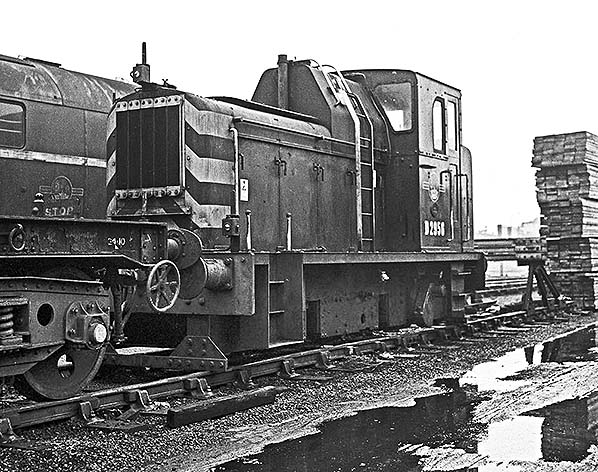
© Chris Burton
Above Barclay 153hp shunter D2956 is seen on 'the dump' at Cambridge. The photographer is reasonably certain the photograph was taken during the late winter of 1965. Quite why this locomotive was at Cambridge wheel-less is something of a mystery. She was one of four; 11503 - 6, later D2953 - 6, new in 1956 for work in the London docks and for that purpose were based at Stratford. Later becoming BR Class 01, two of them became famous for being sent to Holyhead breakwater where they enjoyed long lives still in original black livery but bearing TOPS numbers. Of the other two, D2953 was sold into industry and survives in preservation. D2956 was sent from Stratford to Newton Heath in 1965, then to Doncaster in early 1966 before being withdrawn in May of that year. She went on to enjoy a long life with A. King & Son shunting at their Norwich scrapyard before moving to Snailwell, by which time Kings had become Mayer Newman. She suffered a gearbox failure in 1984 and was donated for preservation. We thus have the strange situation whereby the two class members which survived the longest with BR, those at Holyhead, were ultimately scrapped yet the two early withdrawals have survived - thanks to being sold into industrial service.
One possible reason for D2956 being wheel-less at Cambridge might be that she was en-route from Stratford to Newton Heath when she suffered some sort of major problem which meant she was no longer fit to travel, so was dumped at Cambridge for repairs. As with the North British shunters seen earlier, it was common practice for operational reasons to send locomotives from / to Stratford via Cambridge so this aspect of D2956 being at Cambridge is not surprising - but being dumped there wheel-less is. Given that, at the time, BR had little work left for its motley collection of smaller shunters, it is surprising D2956 was not condemned and scrapped on-site at Cambridge.
After D2956 was withdrawn, another Barclay 0-4-0, departmental 81, took the number D2956. This was the locomotive allocated to Cambridge Engineers Department but which in practice spent much of its time at Peterborough. It was reportedly spotted just once at Cambridge, in the engineers sidings near Mill Road bridge doing the work previously undertaken by Sentinel 42. 81 was very similar to the Class 01s but was two years newer and differed in a number of ways, the most obvious of which was its larger cab side windows. 81, or the second D2956 as it became, did not escape the scrapman.
These Barclays were, despite being visually similar, were different machines to those which became BR Class 06. There was also an 0-6-0 version, D2400 - 9, which spent much of its time in Lincolnshire but with two originally allocated to King's Cross. All the Barclay 0-6-0s had been withdrawn by 1968 and none survived.
The 1955 Modernisation Plan
The 1955 Modernisation Plan was mainly about main line traction, freight and multiple unit passenger stock. The concept and introduction of diesel shunting locomotives predated the plan, as we will call it, by many years, hence we have covered them separately.
 The full and correct title was The Modernisation and Re-Equipment of British Railways and it was a Report published in 1954 describing a planned mass changeover from steam to diesel and electric traction in an attempt to stem losses due to road and air competition. Like the Standard steam locomotives, a perceived added benefit of the plan was to make the railways more attractive for recruitment. Despite the main intention being to stem losses from competition, the absurd situation continued to exist whereby BR was a common carrier but road hauliers could cherry-pick. the plan, however, included steps to streamline freight movement with mechanised marshalling yards and automated shunting.
The full and correct title was The Modernisation and Re-Equipment of British Railways and it was a Report published in 1954 describing a planned mass changeover from steam to diesel and electric traction in an attempt to stem losses due to road and air competition. Like the Standard steam locomotives, a perceived added benefit of the plan was to make the railways more attractive for recruitment. Despite the main intention being to stem losses from competition, the absurd situation continued to exist whereby BR was a common carrier but road hauliers could cherry-pick. the plan, however, included steps to streamline freight movement with mechanised marshalling yards and automated shunting.
The plan was to cost £1.2billion but ultimately much money was simply wasted. An example of money wasted was the Cambridge - Bletchley line; some wartime sidings at Swanbourne were proposed for conversion into a marshalling yard and Bletchley flyover was built. At Sandy the bridge over the ECML was rebuilt while a country house was purchased in Buckinghamshire for use as a training school for staff at Swanbourne yard. Worse was the procurement of diesel traction.
The plan provided for a number of different types of diesel locomotive from a range of manufacturers, but only in small quantities for initial evaluation. This was a sensible move, or it would have been if the idea had been adhered to. The initial orders were for batches of between five and twenty locomotives from different manufacturers, this part of the story being known as 'the pilot scheme'. But instead of evaluating these locomotives properly, which was to have been over a three year period, and weeding out the rubbish from the not so rubbish, BR went guns blazing and ordered further batches before they had even the vaguest idea of what they were dealing with. Earlier, the LMS and the SR built locomotives 10000/1 and 10201-3 respectively using English Electric equipment. These machines were not without their faults but they were broadly successful and should have been a big clue for BR regarding which way to go. To a degree they were as EE locomotives became a big part of the BR scene, but BR ran amok and ordered all manner of untried designs for which locomen and engineers had to learn very quickly. The area from North and East London up into East Anglia thus was chosen as the first area to changeover from steam to diesel traction. This explains why such a wide variety of diesel types could be seen at Cambridge in the early years of dieselisation, as outlined below.
Main Line Diesel Locomotives
From c1971 onwards, Cambridge became synonymous with diesel Classes 31, 37 and 47 plus swarms of rasping diesel multiple units but until that time things were very different indeed.
From 1957 the Brush Type 2 appeared followed by the English Electric (EE) Type 1 and the British Thomson-Houston (BTH) Type 1. Over the following couple of years the EE Type 4 appeared, as did the NBL Type 1 and Type 2, BR / Sulzer Type 2, Birmingham RC&W Type 2, EE Type 2 Baby Deltic These became Classes 30/31, 20, 15, 40, 16, 21, 24, 26 and 23 respectively. In due course the EE Type 3 and Brush Type 4 appeared, becoming Classes 37 and 47 respectively. In due course many other types put in the occasional appearance, including some not native to the area.
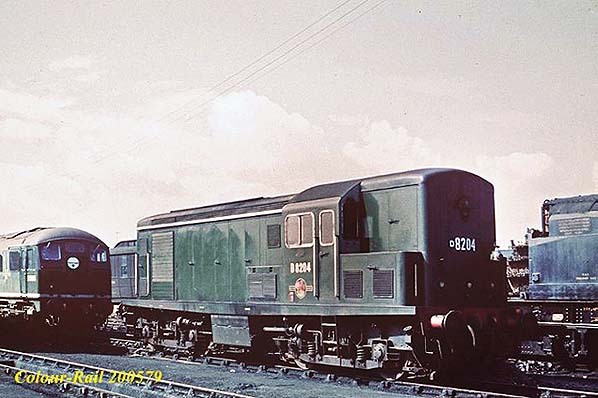
© Colour-Rail
The above scene, taken in April 1960 on 'the dump', was typical of Cambridge at the time but today is difficult to appreciate. D8204 was one of class of 44 BTH Type 1s which later became Class 15. The first ten of these were 'pilot scheme' locomotives. The class, in locomotive form, spent its entire life in the area; some went at first to Devons Road for a time, then many were allocated to Stratford but others were dispersed among sheds in East Anglia. Finsbury Park also had an allocation. They were neat little locomotives and construction was split between the Yorkshire Engine Co. (D8200 - 9) and the remainder by the Clayton Equipment Co. although Clayton supplied some components for the entire class; British Thomson-Houston being the main contractor and supplier of electrical equipment. The class was plagued by its Paxman 16YHXL engines; enormous 16-cylinder units set to develop only 800bhp which gave only something like 550 - 600bhp at the rail. The engines were prone to oil and coolant leaks due to fractures of various components and this could result in fires.
Devons Road was a shed in Bow, East London, in the heart of Eastern Region territory. By virtue of being part of the North London Railway it fell under the auspices of BR's London Midland Region. The BTH Type 1 had been intended for the Eastern Region but at the last minute the initial batch, at least, were sent to Devons Road. The reason is not entirely clear but seems to have been linked to the 1956 Clean Air Act, which the City of London was very keen to implement by, in part, ousting steam traction. As the BTHs came under the LMR, that region tried them out in a number of locations in its jurisdiction including Toton and Scotland. This, however, was short lived and the BTHs soon ended up where intended on the Eastern Region.
The NBL Class 16 (D8400 - D8409) were very similar to the Class 15 but reputedly far more unreliable and more prone to overheating, despite having more ventilation grilles than the BTH offering. The Class 16s also appeared at Cambridge from time to time - if any could make it that far from their Stratford base. When one did appear it was more often than not D8406, for some strange reason. The Class 16 was another 'pilot scheme' type but the class did not grow beyond ten examples.
The Class 15s had a top speed of 60mph, as did the Class 16s, which was adequate for the goods and transfer work they were designed for. They were not fitted with train heating equipment but nonetheless were a common sight on passenger trains during the summer months. They were very common on the Stour and Colne Valley lines between Cambridge and Chappel / Marks Tey on both goods and passenger work. They could also be seen on Cambridge South pilot work from time to time; a job which suited them more than it did the little Class 03 shunters. During the summer of 1965 D8216 was on station pilot work and this had been the locomotive involved with track lifting on the Colne Valley line. For a long time, D8234 was kept looking smart in the best of traditions for Liverpool Street station pilot work. Your author was once granted a footplate ride on the Liverpool Street pilot but on the day in question a rather scruffy D8224 was on duty.
Much of the work intended for the BTH and NBL Type 1s had been lost by the late 1960s and by 1968 all the NBLs and some of the BTHs had been withdrawn. Most of the rest of the BTHs lasted until 1971, D8204 being among them. The number on the nose end was applied to many of the class when new and some of the earlier withdrawals went to the scrapyard still so-numbered. None received blue livery but many received either small or full yellow warning panels and the BR double arrow logo. Towards the end of their lives, the BTHs were often seen in pairs coupled long nose to long nose. By this time drivers' sighting was becoming an issue; this same issue being the reason the EE Class 20s were frequently seen in pairs. On the King's Cross line, the Finsbury Park examples were often seen on the Ashburton Grove - Blackbridge Sidings rubbish trains, a duty which could also make use of the Baby Deltics.
Keeping D8204 company is a BR / Sulzer Class 24 and the Cambridge breakdown train. The crane, just visible on the right, was still in black livery as was the ancient clerestory tool and riding van visible between the two locomotives.

© Colour-Rail
Also on 'the dump', above, is D8215 sandwiched between a pair of Brush Type 2s; that on the right being one of the ''skinhead'' examples. Skinhead was a nickname given to the Brush Type 2s without a roof mounted headcode box. The date is unknown but the presence of small yellow warning panels suggests 1964/5. In the background the redundant water crane on platform 6 can be seen. It has lost its bag but is probably otherwise still operable. D8215 survived until December 1970; this and D8204 being Stratford based at the time of withdrawal. Four of the class became ETH carriage preheaters; D8203/33/37/43 and this is the only time, other than during tests when brand new, the class appeared outside of its native area. One survives, D8233, with its restoration to a working locomotive proving to be a somewhat long-drawn-out affair but this is no fault of the largely volunteer team undertaking the work.
It is worth adding a mention of the problems which plagued many of the early diesel types. Many diesel engines used by BR had been developed from prewar or wartime marine applications, the best known example being the Napier Deltic engine. Marine applications called for a more or less constant output over long periods of time. Paxman engines, for example, were used in Royal Navy WWII submarines and gave little trouble. Many of these engines, however well adapted or developed for rail traction, could not withstand the constant load variations demanded by railway use. This was made worse by BR and their obsession with, rightly or wrongly, keeping weight down. Many engines which in standard form had cast iron cylinder heads and other components were altered at BR's insistence to incorporate aluminium alloy components instead. The result was not good. The Paxman engines of Classes 15 and 16 were so meddled with and some of the Class 15s later received the proper cast iron heads and this improved their availability somewhat. Crankcase method of construction was another contentious issue to which BR meddling could be blamed to a certain degree.
It should be remembered that very few BR diesel locomotives ran problem free straight from the box, as it were. The entire fleet of Brush Type 2s had to be re-engined, the Brush Type 4 fleet gave persistent problems at the beginning, EE locomotives suffered bogie fractures and the EE Type 4 and BR Peaks were too big and too heavy for their power although the latter two could hardly be called unsuccessful. The Deltics, Baby and Senior, were a maintenance liability for their entire BR lives. The Deltics, Class 55 variant, were a necessary persistence in the, then, absence of ECML electrification, but other types of which large numbers were built had to be persisted with to avoid the political and financial disaster which otherwise would have resulted.
Over and above all these problems, which were in no small part due to BR's haste which, it must be said, was to a large degree down to government pressure, came the problems of staff and facilities. Drivers, brought up on steam, had to learn a form of traction which was totally alien to them. It must be remembered that in those days people with knowledge of, and the ability to drive, road vehicles were still a minority. While a huge diesel locomotive was a world apart from a Morris Minor, a basic understanding of how the internal combustion engine functioned went some way towards helping locomen understand the huge diesel engines under their control. An understanding of electric and hydraulic transmissions was also alien to men raised on steam. The haste with which diesel traction was introduced meant facilities were inadequate and many of the early diesels had to share facilities with steam locomotives. The dirt and grime did the diesels no good at all. Thus while history loves to blame manufacturers for the shortcomings of the early diesel locomotives, the manufacturers were by no means solely to blame. To their credit, locomen and engineers soon learned the new form of traction and many drivers came to like the better working environment of a diesel locomotive cab. Many main line diesels had toilets and basic cooking facilities for the crews, while better views of the track ahead, windscreen wipers (rare on steam locomotives) and the relative cleanliness of a diesel cab all made the job somewhat more pleasant. Perhaps more importantly and as was the case with the Standard steam locomotives, crews actually felt they were being thought about for once.
As the railway network shrunk and goods shifted to the roads, it was inevitable that the smaller classes of diesel locomotive would be the ones to succumb. However, had the available work not declined the smaller classes, like the BTH Type 1s, could have gone on to be quite successful had they have been given the persistence lavished on the quantitatively larger classes. Thus the types of diesel locomotive which today are rubbished were in truth merely victims of politics and financial considerations. Another type which was rubbished, albeit nothing to do with Cambridge, was the Metro-Vick Co-Bo. These rather ungainly machines were actually good locomotives, or rather they would have been had they not been given a Crossley 2-stoke power unit. Other than with their engines, the class gave little trouble and BR hatched a plan to retain them and fit EE power units. However, politics and the shrinking rail network saw to it that this plan never came to fruition.
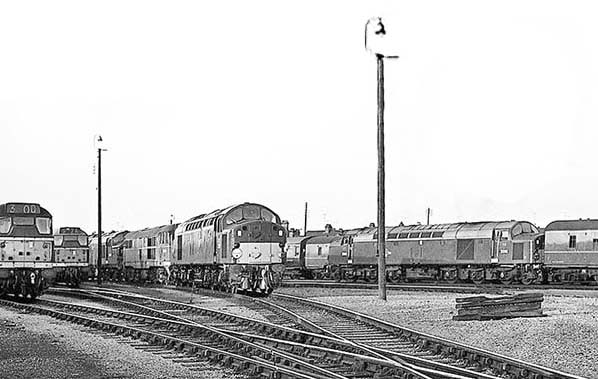
© Chris Burton
Like the previous two images, it is today somewhat beyond comprehension that the above rare view is of Cambridge. On 'the dump', left to right, is D5575, D5603, an unidentified EE Type 3, D5579 and D201. On the right, D209 is departing with the 18:36 Liverpool Street - King's Lynn service. The date is September 1964 - the height of Beatlemania and the year those lucky enough to own a television had, with the introduction of BBC 2, the fantastic choice of three, yes three, TV channels.
The first ten of the EE Type 4s (later, Class 40) had been allocated from new in 1958 to the region, being divided between Hornsey / Finsbury Park for use on the ECML and the Great Eastern section. They took over from the Britannias and operated supposedly accelerated diagrams between Liverpool Street and Norwich via Cambridge or Ipswich and Liverpool Street - King's Lynn or shorter Liverpool Street - Cambridge services from time to time. The bulk of the class, which ultimately totalled 200 examples, mainly worked on the West Coast Main Line (WCML) prior to electrification of that route. The first ten of this class were 'pilot scheme' machines.
Although it is not immediately obvious D 5579, hiding behind D201, is still in its experimental ochre livery. That and D5578 in an experimental shade of blue were a common sight at Cambridge. The success or otherwise of experimental liveries was largely a matter of opinion but D5579 looked quite vile in its ochre, especially when it was dirty. The blue of D5578, which was a quite light shade, looked quite nice albeit a little 'cold'. The two locomotives were repainted into standard green the following year. The Brush Type 2 was another 'pilot scheme' design, the first twenty examples in this case; these were the 'toffee apples', as they came to be known, due to the design of the master controller key. They also had a different control system and could not work in multiple with the remainder of the class. This incompatibility was a problem among many early diesel types. The 'toffee apples' were a familiar sight at Cambridge but were relatively early withdrawals. Some then became carriage preheating units. One, D5518, was damaged in an accident and was rebuilt as a standard locomotive compatible with the bulk of the class. It also morphed from being a 'skinhead' into a headcode-boxed example.
There was 263 members of what became Class 31. From new they had Mirrlees JVS12T engines but, as mentioned, the entire class was re-engined with EE 12SVT units. When Mirrlees engined they were Class 30 and became Class 31 as they were re-engined. As already explained, had the class not been so large it is almost certain they would have not undergone re-engining and would have been withdrawn during the 1960s. In the event, a handful remain in service at the time of writing while several others are now with heritage railways.
The Class 40s, as the EE Type 4 became, had left the area by 1967 with their work being taken over by Classes 31, 37 and 47 with the latter being more common on the Norwich via Ipswich services.
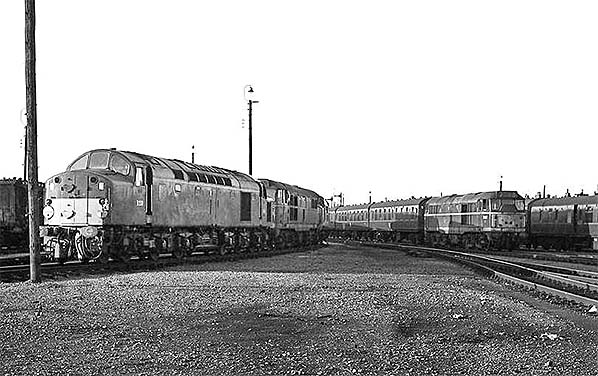
© Chris Burton
The above view was taken at the same time, from a different angle. The train on the right was the 17:46 departure from Hunstanton and it was due to arrive Cambridge at 19:35. These services involved a reversal at King's Lynn. When seeing a locomotive hauled train from Hunstanton, it is hard to believe that just 4½ years after the scene was captured on camera the Hunstanton branch was no more. King's Lynn then became nothing more than the terminus of just one route, that from Ely, following closure of the Dereham and Wisbech lines the previous year.
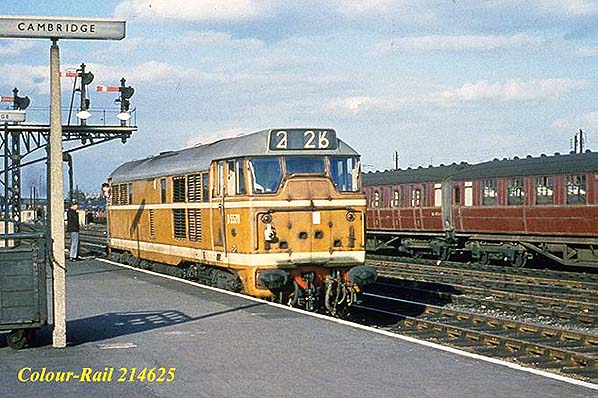
© Colour-Rail
Above, D5579 in all her ochre glory in August 1961. The headcode system was peculiar to the Great Eastern section and 2-blank-26 tells us D5579 had worked a train south from March. The tail lamp, however, tells us D5579 is now a light engine and she is probably waiting at the signals to go onto 'the dump'. On the right some splendid Gresley stock can be seen while the array of signals on the left, installed in 1926, had but a short time left. By 1964 they had been replaced by upper quadrants for the bay and colour lights for the main line. At the time D5579 was photographed she still had a Mirrlees engine, the re-engining programme not commencing until 1964. A 'light engine' is a locomotive running on its own without any form of train. The term 'light' was and still is also used by bus and tram companies when describing a bus or tram running empty and not in service, such as to / from its depot.
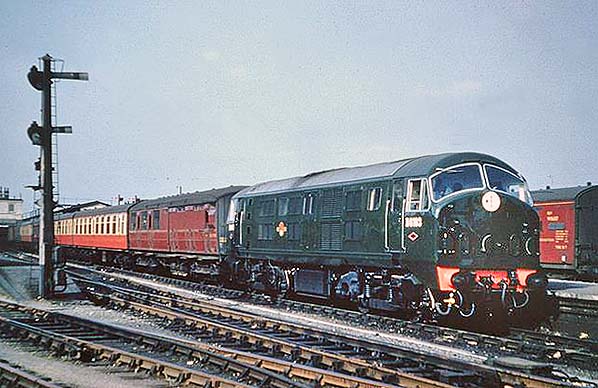
Photo from Rick2E's Flickr photostream
It may come as a surprise to some readers to discover the North British Type 2s were once another common sight at Cambridge. Above D6103 is seen in platform 2 of Cambridge station. The date is unrecorded but the locomotive is obviously brand new so will be sometime in 1959, the class being introduced in December 1958 with D6103 entering service in May 1959. The class totalled 58 and the first 38 were allocated from new to the Eastern Region, at Stratford, Ipswich and Hornsey. This meant Cambridge saw examples from both the Great Eastern and Great Northern sections
D6103 was a Hornsey locomotive and is seen above at the head of a stopping train to King's Cross. She was to remain in the area for just one year before being moved to Scotland.
The first ten of the NBL Class 21s, as they became, were 'pilot scheme' offerings. Although later classed as Type 2 machines, the first ten were of only 1000bhp so technically that made them Type 1s. This batch also had 'red circle' coupling codes, making them incompatible with the rest of the class, and many other types, which had 'blue star' coupling codes. The coupling code allowed two locomotives to be coupled together and operated by one driver, ie in multiple. If codes differed, the locomotives could not work in multiple. The 1000bhp examples were soon uprated to 1100bhp while those which in due course received Paxman engines, in an attempt to improve reliability, were of 1350bhp.
Contrary to popular belief, the NBLs were extremely well built locomotives - apart from their engines. NBL built thousands of excellent steam locomotives for use all over the world but they had no experience of building diesel engines, that is, diesel power units. NBL had built diesel locomotives before, such as the prototype Bo-Bo 10800 and some for export, but installed bought-in Paxman engines. In 1954, perhaps having heard about BR's plans, NBL obtained a licence to build German MAN (Maschinenfabrik Augsburg-Nürnberg) engines. German engineering drawings were, of course, to metric dimensions while NBL, as with almost all other British manufacturers at the time, worked to imperial dimensions. While other manufacturers built German engines under licence with little trouble, such as the Maybach engines built by Bristol-Siddeley, NBL seems to have had serious problems. Engineering tolerances were found to be way off the mark and general build quality was very poor indeed. This was the main cause of the trouble with BR's NBL / MAN locomotives and, it is said, was to play a big part in the ultimate downfall of the North British Locomotive Co.
D6138 onwards were allocated to Scottish sheds from new and within a year or two the earlier batch was sent north to join them. Some, as mentioned, were later given Paxman engines, a two-tone livery (which sat quite well on them) and headcode boxes. They then became Class 29. One, an unrebuilt Class 21, D6122, ended up in Barry scrapyard having been used at Hither Green for rerailing experiments. As paint wore over time, it ended up with its real number on one cab but on the other cab the number D6121 became exposed on both sides. Quite how this came about has been a subject of debate ever since. The numbers were genuine BR-applied as your author examined the locomotive himself at Barry. The most obvious answer might be that a cab swap had once been applied to D6122 but that theory falls apart when it is realised D6122 was never rebuilt and given headcode boxes whereas D6121 was. At Barry, the locomotive lacked a headcode box at both ends. D6122 was the last survivor of the class and as finally scrapped c1980. D6121 and D6122 had both been new to Ipswich depot, from where they pottered around Suffolk branch lines, including the little-known Eye branch, as well as the occasional jaunt west to Cambridge via Newmarket.
Click here to continue Part 7:
British Railways the Diesel Era






 The Drewry offering, later Class 04, was also uncommon at Cambridge despite being prolific at Stratford and a number of sheds in East Anglia. Two which did appear at Cambridge were D2200 (originally 11100) and D2217 (originally 11123). The former was one of the early examples and remained at Cambridge for only a week during September 1962. The latter spent a while at Cambridge in 1957 8, then reappeared briefly on a couple of other occasions during the 1960s. Other then its spells at Cambridge, D2217 was a Stratford locomotive all its life. It was to go on to be the last example of its class in BR service, finally bowing out in May 1972. Stratford was home to a fascinating variety of small diesel shunters, many seemingly spending a great deal of time standing idle on shed. Much of their intended work was in the London docks but as that declined and the general need for shunting locomotives declined, many with withdrawn after very short lives. Numerous examples were sold to industrial concerns where they continued to work for much longer than they did with BR.
The Drewry offering, later Class 04, was also uncommon at Cambridge despite being prolific at Stratford and a number of sheds in East Anglia. Two which did appear at Cambridge were D2200 (originally 11100) and D2217 (originally 11123). The former was one of the early examples and remained at Cambridge for only a week during September 1962. The latter spent a while at Cambridge in 1957 8, then reappeared briefly on a couple of other occasions during the 1960s. Other then its spells at Cambridge, D2217 was a Stratford locomotive all its life. It was to go on to be the last example of its class in BR service, finally bowing out in May 1972. Stratford was home to a fascinating variety of small diesel shunters, many seemingly spending a great deal of time standing idle on shed. Much of their intended work was in the London docks but as that declined and the general need for shunting locomotives declined, many with withdrawn after very short lives. Numerous examples were sold to industrial concerns where they continued to work for much longer than they did with BR.




 The full and correct title was The Modernisation and Re-Equipment of British Railways and it was a Report published in 1954 describing a planned mass changeover from steam to diesel and electric traction in an attempt to stem losses due to road and air competition. Like the Standard steam locomotives, a perceived added benefit of the plan was to make the railways more attractive for recruitment. Despite the main intention being to stem losses from competition, the absurd situation continued to exist whereby BR was a common carrier but road hauliers could cherry-pick. the plan, however, included steps to streamline freight movement with mechanised marshalling yards and automated shunting.
The full and correct title was The Modernisation and Re-Equipment of British Railways and it was a Report published in 1954 describing a planned mass changeover from steam to diesel and electric traction in an attempt to stem losses due to road and air competition. Like the Standard steam locomotives, a perceived added benefit of the plan was to make the railways more attractive for recruitment. Despite the main intention being to stem losses from competition, the absurd situation continued to exist whereby BR was a common carrier but road hauliers could cherry-pick. the plan, however, included steps to streamline freight movement with mechanised marshalling yards and automated shunting.






 Home Page
Home Page